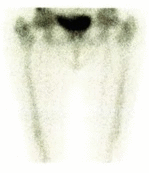Erdheim-Chester Disease: A Rare Clinical Entity
- PMID: 32908822
- PMCID: PMC7473682
- DOI: 10.12890/2020_001630
Erdheim-Chester Disease: A Rare Clinical Entity
Abstract
Pericardial effusion represents a diagnostic challenge. Erdheim-Chester disease (ECD), though a rare cause, should be considered in the differential diagnosis. An 88-year-old woman was admitted to the hospital due to retrosternal pain, dyspnoea and constitutional symptoms. Hypoxaemic respiratory failure and increased inflammatory markers were documented. A chest x-ray revealed an increased cardiothoracic ratio. An echocardiogram showed a moderate-volume pericardial effusion, without signs of cardiac tamponade. A thoraco-abdomino-pelvic CT scan found a bilateral perirenal soft tissue halo. Perirenal mass biopsy showed diffuse infiltration by foamy histiocytes (CD68+), without IgG4, compatible with ECD. The correlation of anamnesis, radiology and histology is crucial for the diagnosis of ECD.
Learning points: Erdheim-Chester disease is a non-Langerhans cell histiocytosis that affects multiple organs and systems.Thorough study of a pericardial effusion is important as it is still considered idiopathic in 10-20% of cases.It is a rare disease so high diagnostic suspicion is important. The diagnosis is established through clinical manifestations, radiologic findings and histological confirmation.
Keywords: Erdheim-Chester disease; pericardial effusion; retroperitoneal space.
© EFIM 2020.
Conflict of interest statement
Conflicts of Interests: The Authors declare that there are no competing interests.
Figures





References
-
- Houston BA, Miller PE, Rooper LM, Scheel PJ, Gelber AC. From dancing to debilitated. N Engl J Med. 2016;374(5):470–477. - PubMed
LinkOut - more resources
Full Text Sources
